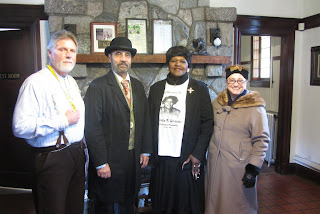History Walk, 2017 - Bright Ideas: Kenosha's Inventors
Kenosha was an automobile industry town from 1900 to 2010, and this year's Walk reflects that industry, as 4 of the 5 reenactments were inventors of automobile-related parts and equipment.
Nicholas Demos invented the multi-car transit trailer.
Arthur Kneibler owes his wealth not to the automobile industry but to his unique invention in men's undergarments - the Jockey brief!
Mrs. Stanton Palmer tells of her husband's early demise, after being at the helm of Snap-On Tools.
Martin Winther and his brother Anthony had almost 300 patents to their name for various car and truck related devices.
Richard Welles, father of famous actor/producer Orson Welles, invented bicycle and automobile head lamps and accessories.
History Walk, 2016 - Kenosha School Namesakes
Michael Frank, Gilbert S. Lance, Edward Bain, Judge Gillett, Mary D. Bradford, and the Lamb family all had schools named after them. Some were educators, some were instrumental in establishing the first free schools west of the Allegheny Mountains, and still others were prominent business leaders who served on the school board.
History Walk 2015 - Kenosha: Park CIty and Her Namesakes, Part 2
William W. Isetts II was a land developer and businessman who, along with his wife Dolly, was an avid hunter and marksman. The two of them won many shooting competitions and their home was a veritible museum of animal trophies, which were donated to the Kenosha Public Museum by Isetts 2nd wife.
Other individuals reenacted were Walter H. Alford, Henry L. Bullamore, George Limpert and Mrs. Claus Clausen.
History Walk 2014 - Kenosha: Park City and Her Namesakes
Four reenactors brought to life former Kenoshans.
Eichelman Park on the shores of Lake Michigan was named for immigrant Bernhardt Eichelman, a tailor, photographer, and property owner who donated his land to the City.
Dr. Nelson Pennoyer opened the Pennoyer WAter Cure and SAnitarium along Pike Creek. His park holds the bandshell where the Kenosha Pops Orchestra regularly holds summer concerts.
Cornelia R. Streeter was reenacted by her daughter Rochelle. Cornelia worked diligently to establish a tot park to keep neighborhood children safe close to home instead of walking to the distant Lincoln Park.
Janet Lance Anderson, widow of James, donated land for a park as well as her home to be given over upon her death.
The Library Park district of Kenosha was home to some of the more prestigious families in the early days of the city's history.
Mary Head was the strong-willed daughter of the town's famous, hot-headed lawyer. She ran off and married a man "beneath her" status, possibly contributing to her father's early death.
Nathan R. Allen, Jr. grew the Allen Tannery into the worlds' largest leather shoe and harness manufacturer.
Louisa K. Thiers lived to the age of 111, and was an original Daughter of the American Revolution.
Urban J. Lewis became head cashier at his father-in-law, Daniel Head's bank. His final months were filled with terrible suffering.
Volney French (told by the woman who owns his house) was an early settler to Pike, as Kenosha was then known, among the first attorneys and later a probate court judge.
History Walk, 2012 - Great Women of Kenosha
The name Alford is familiar to Kenoshans; Mrs. Gertrude (Walter) Alford was a leader in starting the Girls Scouts in Kenosha, and donated land for a camp as well as the present day headquarters off of 22nd Avenue at Woodhaven.
Jane Pfennig Henkel was the daughter of a former mayor who escaped death as a young teen. Lauretta Dibble was born in Kenosha and died in Kenosha, but she spent most of her life as a missionary teacher to girls in Angola; some artifacts she brought back are part of the Collection at the Kenosha Publice Museum. Harriet Yule was a colorful character during the early part of the last century. Dr. Helen Harbert was a prominent woman in the Danish community and her medical expertise aided Kenosha during the influenza pandemic.
2011 History Walk presented "Kenoshans in Wartime."

Augustus Quarles served in the Mexican War and was the first Wisconsinite to die defending the state; Antoine Dodge, slave of 1st territorial governor Dodge, fought in the Civil War and settled afterwards in Kenosha; James K. Balcom fought out West in the Indian Wars; J. Truman Streng experienced trench warfare during World War I, and Kenosha had its share of "Rosie the Riveters" at Nash-Kelvinator, including Theresa Johnson.
History Walk, 2010

This year's Walk featured Henry S. Cooper, one of the founders of Cooper Underwear Company, now Jockey, International, and grower of prize-winning peonies; Zalmon G. Simmons, founder of Simmons Mattress Company; Thomas Jeffery, inventor and manufacturer of Rambler bicycles and automobiles; and a Chicago reporter telling the tale of Edward Bain, founder of Bain Wagon Works, who was shot by a jilted lover.
Special thanks to Roger for driving his 1902 Jeffery Rambler to the Jeffery Mausoleum!

History Walk, 2009
Lorinda Merrill (Carol K.) was the first female lightkeeper at the 1866 Southport (now Kenosha) Lighthouse.
History Walk, 2008
Kate Deming (Allison S.) helped protect the secret that her father, Reuben Deming, a Methodist minister, was a conductor on the Underground Railroad, helping runaway slaves escape to Canada through Kenosha harbor.History Walk, 2007
Carthage College Theater Department students (Marcy R. & Mark B.) portray Bridget and John McCaffery. After John drowned his young wife Bridget in their backyard cistern, he was condemned to death by hanging. However, his death was so gruesome, taking about 15 minutes, that the state banned capital punishment. As a result, John became the only person to be put to death by the state of Wisconsin.








